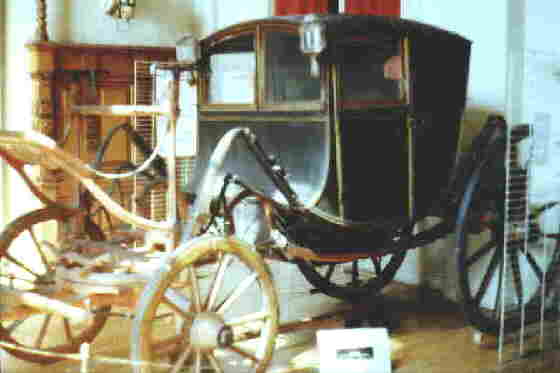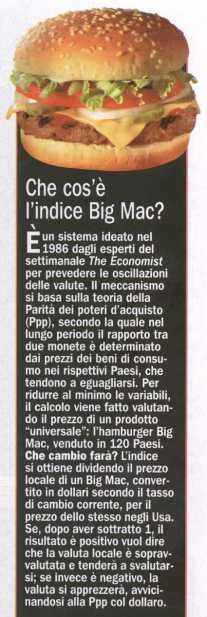


The "Braten" Index
1. Wealth Comparisons: gossip or science?The "Braten" Index We are quite familiar with questions like the following:
Were the Rockefellers the richest family in history? Or perhaps the Rothschilds, or the Vanderbilts? And what about Bill Gates?These rather frivolous questions and comparisons appear frequently in gossip magazines. However, social historians and economists are also systematically confronted, at a much more serious level, with the following question:
Was "Gone with the Wind" the greatest box-office success in history, or was it really "Titanic"?Is there any meaningful method to compare the wealth or well-being of societies and individuals across national borders and time?This problem is indeed central to many theoretical and practical problems in Economics and the Social Sciences. The following quotation [Ref. 1] shows just one area where the solution of the "wealth comparison" question is important:"Comparisons of wage rates across countries have become key ingredients in evaluating theories of international trade, the role of trade in exacerbating wage inequality, and the role of capitalist reforms in economic transition."Thus the problem of wealth comparison is not just a matter of "keeping up with the Joneses", it is really a very important area of theoretical and practical Economics.At first sight, the problem of comparing wealth or well-being across space and time may look trivial, at least since the invention of money and of exchange rates, because:
the comparison of two money quantities across countries may be carried out just by applying the corresponding bank exchange rate, for instance from dollars to euros.The wealth comparison problem would thus be reduced to just 2 simple operations of multiplication! What are then we worrying about?
the comparison across time may be performed by referring to the official "Inflation Indexes" compiled by Central Banks in most countries.
In fact this apparent simplicity is very misleading, and the problem is actually extremely difficult to solve, because of the following reasons:It is not at all easy to obtain reliable historical data on exchange rates before the middle of the XIXth century. The arduous work carried out by Pablo Günther [Ref. 2] and by Georges Coppel [Ref. 3] in the case of the XVIIIth century is a very good example of the difficulty of this task.In general, therefore, the main difficulty presented by the "wealth comparison" problem is the fact that we can compare only equivalent quantities, and unfortunately there is usually no general agreement as to what "equivalent" means.
Comparisons across time may also be very difficult, because the goods and services considered by people as needs or as luxuries change substantially due to scientific and economic progress.
The work of Georges Coppel [Ref. 3] contains a particularly clear exposition of the difficulties encountered in this respect.
Comparisons across national borders may be rendered meaningless if the cost of living is very different between the countries being considered. We may quote again [Ref. 1]:"Despite the importance of cross-country wage comparisons, it is widely agreed that no credible, comparable wage estimates exist."
How do we compare, for instance, teachers' salaries between different countries? If the countries selected have roughly similar standards of living and similar cultural attitudes, we might perhaps reach useful conclusions quite easily, but can we make a meaningful comparison otherwise? How do we take into account the differences in the cost of living between two countries, or the different social prestige attached to the profession? The same difficulty arises when the comparison is carried out across extended time periods.
In view of all these difficulties, is it at all possible to find a "universal wealth benchmark" that would serve as a "unit of wealth", one that we could use in general consensus, in the same way that we use the meter or the second everywhere?
Furthermore, is it possible to make this unit of wealth "simple", so that most people could use it intuitively, without requiring a degree in Economics?3. A Scientific solution: The "Purchasing Power parity" (PPP) Index
The general method used by social scientists and economists in order to compare wealth is called "Purchasing Power Parity" (PPP).
This method consists roughly in defining a "standard basket" of the main goods and services that are considered representative of the normal consumption of an average person or family: food, energy, clothing, transportation, education, entertainment, medical care, etc., etc.
If we succeed in defining a really representative "basket", then the "standard of living" of any individual, or group of individuals, may be measured by the "number of baskets" that they can buy - purchase - with their monthly or annual income. The "standard basket" supplies therefore a fairly objective unit of measurement, and we may reasonably agree that if the incomes of two individuals allow them to buy the same number of their respective baskets, then their wealth or well-being may be considered quite similar. Hence the expression "Purchasing Power Parity" (PPP).
The PPP method has several practical limitations:The definition of a really representative basket is very difficult, even for people in the same country, because persons with different incomes do not consume the same things, i.e., their "consumption patterns" may be quite different.Is then there no solution at all? Is there no hope of finding a "universal basket" that would be applicable to different levels of income, different countries, and different periods of time?
Consumption patterns also change substantially from one country to another and from a given historic period to another, and the comparisons are again very difficult.4. The "Big-Mac" Index: "Burgernomics" and "McParity"
In 1986, the British magazine "The Economist" proposed - tongue in cheek - the application of the "Big Mac" index. This index is described, in their own words [Ref. 4], as follows:
"We launched the Big-Mac index as a light-hearted guide to whether currencies are at their "correct" exchange rate. It is not intended as a precise predictor of exchange rates, but a tool to make economic theory more digestible.The Economist thus replaced the theoretical "representative basket of goods and services" used by the PPP method by just one item: a McDonald's Big-Mac hamburger! In other words, they were assuming that this product alone could be as representative as a complex "standard basket", carefully defined by economists and market researchers!
Burgernomics is based on the theory of purchasing-power parity (PPP), the notion that a dollar should buy the same amount in all countries. Thus, in the long run, the exchange rate between two currencies should move towards the rate that equalizes the prices of an identical bag of goods and services in each country. Our "basket" is a McDonald's Big-Mac, which is produced in about 120 countries. The Big-Mac PPP is the exchange rate that would mean that hamburgers cost the same in America as abroad. Comparing actual exchange rates with PPPs indicates whether a currency is under- or overvalued."
The Big-Mac started of course rather as a joke, but - surprise! - the notion has since proved to be quite useful, and it has now entered the academic and the practical worlds, where it will apparently stay in the foreseeable future. As The Economist - still tongue-in-cheek - puts it:"Some readers beef that our Big-Mac index does not cut the mustard. They are right that hamburgers are a flawed measure of PPP, because local prices may be distorted by trade barriers on beef, sales taxes, or big differences in the cost of non-traded inputs such as rents. Thus, whereas Big-Mac PPPs can be a handy guide to the cost of living in countries, they may not be a reliable guide to future exchange-rate movements. Yet, curiously, several academic studies have concluded that the Big-Mac index is surprisingly accurate over the longer term.There exist currently many academic studies and publications that apply - in all earnest - the Big-Mac index. Please refer to the list of references in Section 7 hereunder.
Indeed, the Big-Mac has had several forecasting successes. When the euro was launched at the start of 1999, most forecasters predicted that it would rise. But the euro has instead tumbled - exactly as the Big-Mac index had signaled. At the start of 1999, euro burgers were much dearer than American ones. Burgernomics is far from perfect, but our mouths are where our money is."5. Extending the Validity of the Big-Mac Index
The Big-Mac Index is of course valid only from the second half of the XXth century onwards. Is it possible to adapt it, in order to extend its validity further into the past? Is it possible to find another product that we could choose as a "wealth unit" with similar success?
What makes in fact the Big-Mac Index so successful? There are several reasons for this:the product is identical across many countries.If we start thinking along these lines, then some basic food products such as bread, wine, or beer come readily to mind. Indeed, all these products have actually been used as "wealth units". Bread, however, is too basic to be really representative of people's well-being, whereas wine and beer do not have the same importance in different countries.
it satisfies a basic need.
it is popular.
it is fairly accessible to most people.
In order to approach the qualities of the Big-Mac we must create in fact an abstract notion: the "Basic Meal", defined roughly as the standard popular meal in a country or a group of countries.
The "Basic Meal Index" allows us to extend the validity of the Big-Mac Index to practically any historic time we may wish to include in our comparisons. Indeed, we might even compare the wealth of Crœsus with that of Solomon, or that of Bill Gates!
There is, of course, one unfortunate difficulty: the "basic meal" must be defined for each country and each historic period. This requires of course much research into food habits, and certainly some arbitrary choices (e.g., should we choose pasta or pizza in the case of Italy?).
This type of problem may usually be solved by restraining our field of study to a given historic period. The following section presents the very practical solution found by Pablo Günther for carrying out cost-of-living comparisons in XVIIIth century Europe.6. Pablo Günther's "Braten" index
Keen casanovists like Pablo Günther wish of course to relate to their friend Giacomo and to the circumstances of his life. They would like to understand as well as possible the motivations for his attitudes and his actions.
Apart from some background in psychology, which shall not concern us here, this understanding of Casanova requires certainly a good perception of his permanent efforts to improve and to secure his social and economic situation. Furthermore, these goals must be adequately interpreted in the context of the XVIIIth century.
With these purposes in mind, Pablo Günther has undertaken the very difficult task of extending the validity of the Big-Mac index in history, and to find an index applicable to Casanova's time.
He has therefore looked for a "basic meal" that could be reasonably used as "well-being unit" in the European area at that time. His research has shown that a very good candidate for this role would be a "Teller Fleisch mit Gemüse", i.e., a simple meal of meat with vegetables (from a cook-shop in Berlin).
Obviously, "Teller Fleisch mit Gemüse Index" is a rather unwieldy expression! For euphonic reasons, therefore, historical precision has been twisted just a little bit, and the new index has been called finally the(the more so since the cook-shop price for a portion of roast meat was - on average - the same as for the "Teller Fleisch mit Gemüse")."Braten" (Roast Meat) Index [cf The Casanova Tour ]
This is a generalization of the Big-Mac Index that may prove as useful as its modern version, provided it is used with some scientific precaution and as much sense of humor!
This new index should be certainly applicable to the meat-eating European countries. It might be somewhat less appropriate for Italy or Spain. In any case, a search should certainly be started in order to collect as many "Braten Index" data as possible!7. References
1.) Ashenfelter, Orley, and Jurajda, Št?pán.
Cross-country Comparisons of Wage Rates: The Big Mac Index.
Industrial Relations Section, Princeton University, Princeton, New Jersey, U.S.A.
2.) Günther, Pablo.
The Casanova Tour, Part XVI, Currencies.
Website: www.giacomo-casanova.de.
3.) Coppel, Georges.
L'argent de Casanova.
Colloque International Casanova, Université Stendhal, Grenoble, France, 8-10.Oct.1998.
To be published by Editions Champion, Paris, France.
4.) Big-Mac Currencies.
The Economist, April 27th, 2000.
5.) Cumby, R.
Forecasting Exchange Rates and Relative Prices with the Hamburger Standard: Is what you want what you get with McParity?
National Bureau of Economic Research Working Paper N° 5675.
6.) APESMA: Association of Professional Engineers, Scientists, and Managers - Australia.
APESMA has established the APESMA Big-Mac Index in order to compare graduate engineer salaries internationally. Refer to the APESMA website.
7.) MacDonald, Rich (!!!).
The Big-Mac Index.
Website: EconEdLink Lessons in Economics, National Council on Economic Education.
Center for Economic Education, St.Cloud State University, Minnesota, U.S.A.
8.) Currency Trading Platform.
Website: www.oanda.com.
This website supplies to its users both the actual exchange rates and the corresponding Big-Mac indices.
Copyright by Hector Zerbino, Paris 2002
